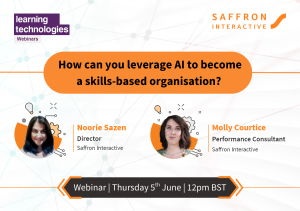Gasping, giggling, action, suspense, intrigue, elearning… which is the odd one out? The misconception that elearning is only ‘click next’ interactions is (hopefully) behind us. But do many people think elearning can be playful – even emotional? At Saffron, narrative has always been a fundamental feature of our instructional design. We tell stories that hold the learner’s attention, throw them deep into drama, make them laugh; recognise themselves in the narratives and lead to real-world behaviour changes.
Let’s talk a little about the power of immersive storytelling.
Learner retention
Stories are more than a bit of fun. Jerome Bruner was an educational theorist who dedicated his career to examining the relationship between learning and culture. Bruner found that, at a statistical level, a learner is 22 times more likely to remember information within a narrative. Being memorable, structured and personal, stories can increase learner retention.
Stories also tackle that massive hurdle – learner engagement. Because who doesn’t want to get involved in the drama of a good story! When you turn on your computer and suddenly become the protagonist in a film-noir-esque story, or find yourself embroiled in an unfolding scandal, you invest in that learning experience. In one of our webinars James Tyas spoke about the psychological concept of ‘flow’ – that state when you get absorbed in what you are doing, loose sight of time and momentarily switch off your reflective self-conscious. Stories in films, novels, conversations and now, elearning, can bring about that ‘flow’ state and lead to increased learning focus.
So, where does the ‘immersive’ bit fit in? For a lot of people ‘immersive experiences’ might mean big budget VR headsets or extravagant performances in giant warehouses. But immersion is really all about being inside something. When we are immersed in a task, or a play, or a football match we feel entirely involved in the event.
The narratives we build at Saffron are immersive because they are all about throwing the learner deep into the narrative. They become the agent and protagonist in a growing story. They don’t just watch, they act.
Application
Educationally, immersion is all about participation and negotiation.
Although educational theories on active participation usually revolve around children’s play, participation is still crucial to adult learning. When learners participate, they are given what adult learners need the most – autonomy. Having control of their choices, actioning their sense of self and following the consequences of their actions within an immersive scenario leads to personally invested autonomous learning.
But what good is this learning if it is happening in the fictional narrative world? Well, immersion allows for negotiation. Yes, learners do throw themselves headfirst into a rich immersive simulation. But this safe fictional play space is very much linked to the real world. Just like children pretending to cook dinner, adults get a chance to practice real world behaviours in play. As Bruner points out, through narrative engagement we, as learners, get the opportunity to ‘construct a place for ourselves in the possible worlds we [have yet to encounter]’ and can relate our play to real life.
An old tale…
I’m new here at Saffron and I was inspired to write this blog post when I looked back at one project in particular. Saffron had made this course to improve a client’s customer sales service. But rather than creating a realistic scenario, our instructional design team got really creative…
The learner was introduced to an immersive fairy-tale narrative full of their favourite fictional characters. Guided by an optical fairy godmother (OFG), learners interacted with a twenty-first century Prince Charming who ‘wants it all’ but had a ‘significantly diminished fashion budget’, and an ‘outburst prone’ Rumpelstiltskin.
Charmed by the magical world around them, the learner then performed real life behaviours, like greeting the customer or picking up the telephone. The immersive storyline made the experience more engaging, memorable and thought provoking!
The end…
You don’t have to use VR technologies to create an immersive learning experience. Immersing our learners means creating a story so rich that they feel like an invested protagonist. Stories are powerful educational tools which can bring about increased engagement, retention and real-world behaviour change.
And by allowing learners to lose themselves in playful encounters with content, Saffron have created highly engaging narrative-based learning experiences which learners want to explore.
If you fancy hearing some of the stories we’ve told, then check out this case study or get in touch.





